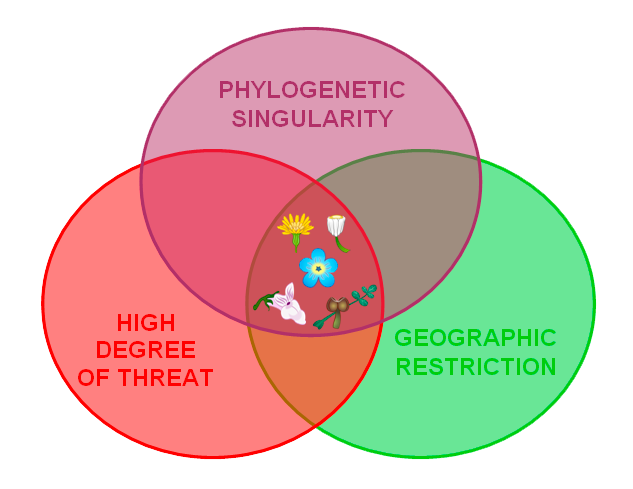Biodiversity and conservation of endangered species
Biodiversity describes the great variety of living beings on Earth, from the tiniest bacteria to the most majestic trees, to human beings or the most common plants.
Why does conserving plant diversity matter?
One of the most common questions when talking about the conservation of endangered species is: “What purpose does this plant serve?” Plants are an important source of oxygen, food, medicines and a wide range of materials. However, their value for conservation goes beyond their practical or economic value.
We estimate that there are around 350,000 flowering plant species on Earth and that one in every five is in danger of extinction. However, humans only use around 300 species – less than 1% of the existing species – and only some thirty cover 95% of our diet.
According to this, we could think that it does not really matter if some species disappear. However, maintaining a high biodiversity is vital for the survival of the planet. Indeed, the greater the number of species there are and the wider the variety of ecological functions the carry out, the greater the chance that more of them will be able to confront and adapt to future changes and perturbations, and therefore be able to persist.
Moreover, we cannot forget that the natural heritage is part of our country’s wealth. And so, just as our country prohibits the destruction of unique books, novel artwork or historic monuments, so should aggression towards our natural heritage be actively prosecuted.
Endemisms: plants that are not found in any other place on Earth
Endemic plants are those that are only found in a specific geographical area, are unique to that territory and cannot be found naturally in any other place on Earth. It must be emphasized that being an endemism is not a synonym for being endangered, although it is for being part of the natural heritage of a region.
The Mediterranean Basin is recognized as one of the most diverse regions on the planet. It holds around 25,000 plant species, 52% of which are endemic to this region. Additionally, around 15% of these endemisms are found in our country. The great diversity of Mediterranean species makes this region a priority for conservation at an international level.
Endangered species in Spain
Spain is one of the most biodiverse countries in the Mediterranean. It is calculated that we posses around 7,500 species of flowering plants, among which 15% would be catalogued as endangered, according to the Spanish Atlas and Red Book of the Vascular Endangered Flora.
These endangered species are not evenly distributed throughout our geography. Indeed, biodiversity hotspots present a greater number of endangered species and unique lineages. These areas of great global diversity in our country are primarily the Balearic and Canary Islands, as well as the mountainous areas of the Béticas and Pyrenees mountain ranges.
What does it mean to be Critically Endangered?
‘Critically endangered’ species are those that present an extremely high risk of extinction in the wild in the immediate future. This is the highest category of threat according to the International Union for the Conservation of Nature (IUCN), and below which the ‘Endangered’ and ‘Vulnerable’ categories would be found. All this knowledge has been accomplished through decades of field study and experimentation.
The IUCN (www.iucn.org) is the world’s oldest global ecological organisation. Their Red List of Endangered Species provides the most complete information about the conservation status of both plant and animal species at a global scale. The precise criteria to evaluate species’ risk of extinction constitute a valuable tool to establish conservation measures.
Conservation priorities
One of the problems that comes up when establishing conservation plans, given the inherent shortage of economic resources allocated for conservation, is determining in which species to invest more effort and resources. Therefore, developing a Spanish catalogue of priority species for conservation would be needed. For this purpose, three of the most significant criteria need to be taken into account:

Based on these three criteria, the Cero Project of Endangered Species has selected the plants that present the greatest urgency for conservation of the Spanish flora, since they are the last living representatives of their genera and lineages (phylogenetic singularity), they are endemic (geographic restriction) and they are critically endangered (high degree of threat).
Why concentrate our efforts on the conservation of living fossils?
Living fossils are species with high phylogenetic diversity, as they have remained evolutionarily isolated during many millions of years and do not currently have closely related kin. Thus, they show a higher relative weight in the total biodiversity than those species that have appeared most recently. In line with the previous example, it is not the same to save a famous painting from the fifteenth century than to save one, let’s say, painted by the researches of this project...
To be considered living fossils, species must fulfil three premises that are linked to the three main criteria for ranking endangered species:
- To be a species with declining populations (criteria of geographic restriction and high degree of threat).
- To belong to lineages depleted in number of species (criteria of phylogenetic singularity).
- To have originated at least by the Cenozoic era, more than 2.6 million years ago (criteria of phylogenetic singularity).


